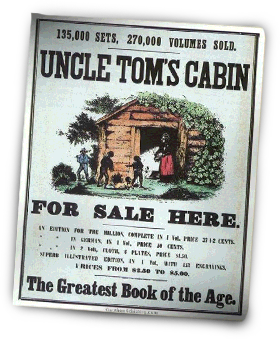Uncle Tom’s Cabin, or Life Among the Lowly was written by Harriet Beecher Stowe. It tells the stories of three slaves – Tom, Eliza, and George – who are owned by a farmer in Kentucky. When the farmer is forced by debt to sell Tom and also Harry (the son of Eliza and George), Eliza takes Harry and runs. She is chased by slave-catchers but manages to escape to free territory. George, who is owned by a different master, also escapes to join his family.

Uncle Tom’s Cabin, first edition
Tom is not so lucky. He is taken away from his wife and children. He is first purchased by the kindly Augustine St. Clare after Tom rescues St. Clare’s little daughter Eva from drowning. Eva begs her father to buy Tom, and Tom becomes the head coachman at the St. Clare plantation. St. Clare also purchases the young female slave Topsy. Tom spends most of his time with the angelic Eva, listening to her read the Bible to him.
Eventually Eva falls ill. Before dying, she gives a lock of her hair to each of the slaves, telling them that they must become Christians so that they may see each other in Heaven.

“Little Eva reading the Bible to Uncle Tom in the arbor”: illustration from the first edition
Tom is next sold the villainous Simon Legree, a Northern slave-dealer turned plantation owner, who also buys two young women, one intended as the sexual slave of Legree’s black overseer, the other for Legree himself. Tom is set to picking cotton, and he tries to make the best of his position by prayer and hope. He is whipped mercilessly for attempting to help his fellow slaves, and Legree vows to break his spirit or kill him. Finally Tom is beaten to death. His firm Christian principles in the face of his brutal treatment made him a hero to white readers.
Uncle Tom’s Cabin was the best-selling novel of the 19th century and the second best-selling book of that century after the Bible. The book’s impact was so great that when Abraham Lincoln met Stowe at the start of the American Civil War, Lincoln is often quoted as having declared, “So this is the little lady who made this big war.”
The characters of Uncle Tom, Little Eva, Topsy, and Simon Legree have all achieved iconic status in American culture.

Stowe, though not an active abolitionist herself, was opposed to slavery. When the Fugitive Slave Act was passed in 1850, Stowe decided to make a strong statement against the institution. She had been working as a freelance journalist to supplement her husband’s small income and help support their six children. In June 1851 Stowe began publishing Uncle Tom’s Cabin in serialized form in the National Era. Her stories, published in forty installments over the next ten months, were inspired by the 1849 autobiography of former slave Josiah Henson, who had established a settlement for fugitive slaves near Ontario, Canada.
In March 1852, a Boston publisher decided to issue Uncle Tom’s Cabin as a book and it became an instant best seller. Only 5,000 copies of the first edition were printed. They were sold in two days. By the end of the first year, 300,000 copies had been sold in America alone; in England 200,000 copies were sold. About two million copies were sold worldwide by 1857. For a three-month period Stowe reportedly received $10,000 in royalties.

Uncle Tom’s Cabin had a tremendous impact. Across the nation people discussed the novel and debated the most pressing sociopolitical issue dramatized in its narrative — slavery. Stowe convinced many readers that the institution of slavery itself was evil, because it supported people like Legree and enslaved people like Uncle Tom. Because of her work, thousands rallied to the anti-slavery cause.
Southerners were outraged, and declared the work to be criminal, slanderous, and utterly false. A bookseller in Mobile, Alabama, was forced out of town for selling copies. Stowe received threatening letters and a package containing the dismembered ear of a black person. Southerners also reacted by writing their own novels. These depicted the happy lives of slaves, and often contrasted them with the miserable existences of Northern white workers.

It is ironic that the book which contributed so much to the cause of abolitionism came to have a rather tarnished reputation. Uncle Tom, though he defies white authority to help his fellow slaves, is forgiving in the face of absolute brutality and suffers countless indignities with patience. This helped whites see the evils of slavery, but it also fostered an image of the submissive, childlike black man — an idea exaggerated in theatrical productions of Uncle Tom’s Cabin. Additionally, the young slave girl Topsy is often seen as the origin of the pickaninny stereotype of black children and black dolls.
You can judge for yourself by accessing a free copy of the book via Project Gutenberg here.
Filed under: History | Tagged: Black History, History, Slavery |




Leave a comment